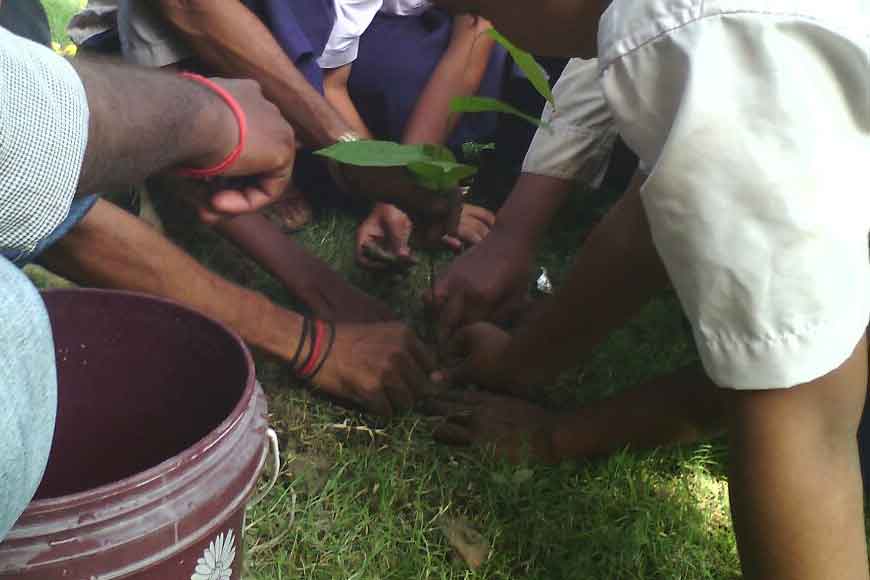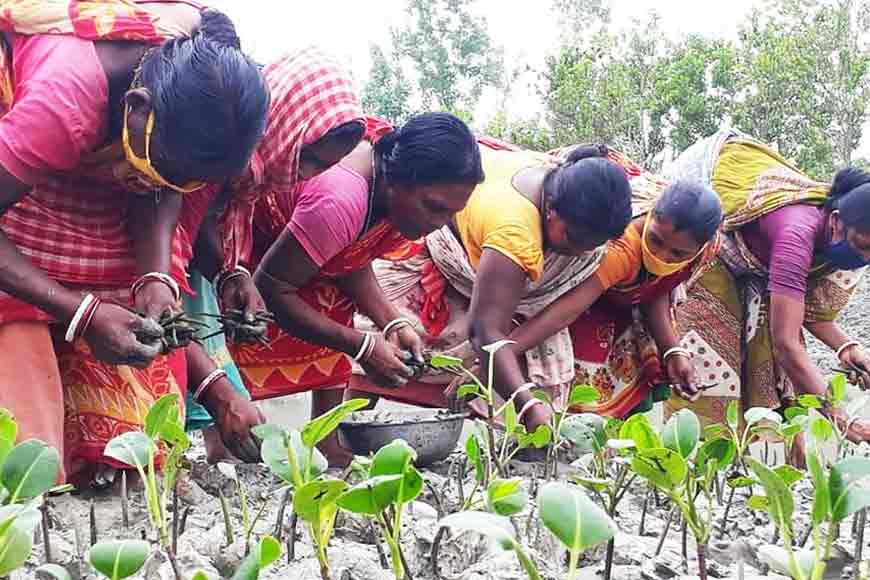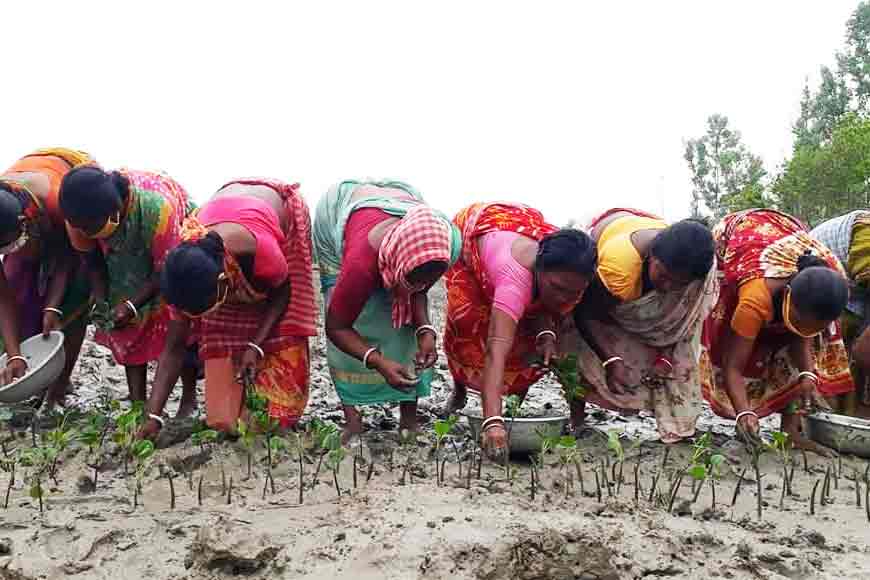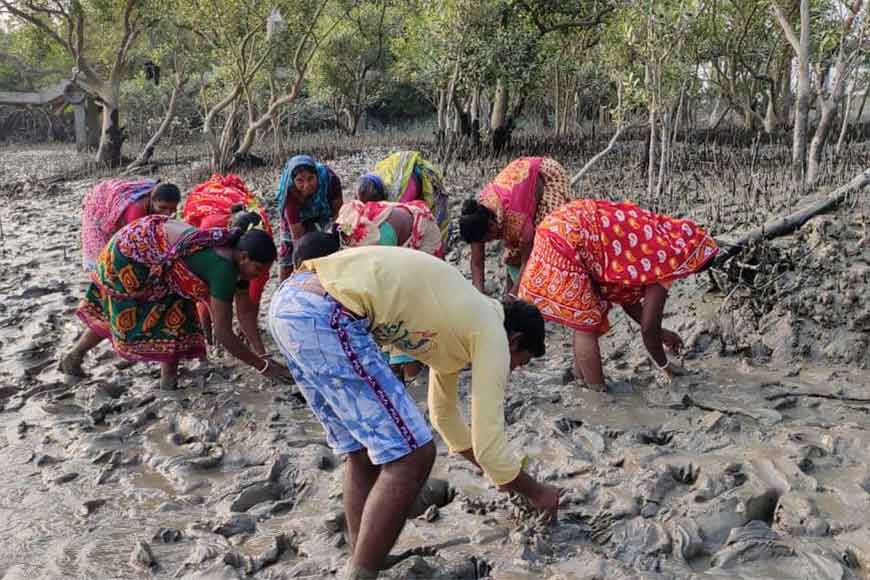Bengal to lead mangrove forestation scheme nationwide to stall coastal erosion - GetBengal story

The Union government launched the MISHTI scheme to protect mangrove ecosystems.
When Cyclone Yaas slammed into the coastal areas of West Bengal on May 26, 2021, it inundated several villages in the Sundarbans region. Jharkhali, a low-lying village in South 24 Parganas district, however, did not face a strong impact. The storm neither breached the river embankment nor rendered the residents here homeless, as it did elsewhere. Surrounded by rivers Matla, Bidyadhari, and Herobhanga, on three sides, the region is cyclone-prone, and the villagers have witnessed the devastating effects of previous cyclones, including Aila (May 2009), Fani (May 2019), Bulbul (November 2019), and Amphan (May 2020), before Yaas in May 2021.
The impact of Yaas was considerably reduced at Jharkhali primarily because of the mangrove saplings that the villagers have grown at the embankment, meant as a coping mechanism against cyclones and tidal waves. Around 300,000 mangrove saplings have been planted since 2017. Much of this is because of the efforts of the women of Jharkhali Sabuj Bahini, an NGO formed in June 2005.
 West Bengal government to lead a nationwide mangrove plantation drive
West Bengal government to lead a nationwide mangrove plantation drive
The state government’s mangrove plantation drive along the coastal areas of the state after Cyclone Amphan in 2020 has been a great success. Millions of mangroves have been planted along suitable coastal areas since then. They are also widely acknowledged for their carbon sequestration potential to mitigate climate change. According to the state Forest Department, around 15 crore mangrove saplings were planted in the state last year. In a recent move, citing the West Bengal government’s mangrove plantation drive as a model for the rest of the country, the Union government launched the Mangrove Initiative for Shoreline Habitats and Tangible Incomes (MISHTI) scheme. This programme focuses on mangrove reforestation along the coastal districts of India and develops mangrove-associated ecotourism initiatives and livelihood generation. The Union government has proposed to the state government to initiate the mangrove plantation module nationwide.
A 2014 document published by Wetlands International and The Nature Conservancy stressed the point that existing mangrove forests could reduce erosion by lowering the impact of wind and waves. However, it also said, "In areas with erosion, mangrove restoration may require more active intervention, such as protecting individual seedlings or restoring the sediment balance and hydrology."

Prior to the 18th G20 Heads of State and Government Summit, scheduled to be held in New Delhi on September 9 and 10, senior Union government officials visited several parts of the state and discovered the mammoth mangrove plantation drive undertaken by the state government. They wanted to find out all the details of the scheme. The state Forest Minister, Jyotipriya Mallick said, "The officials of the G-20 team were very happy to observe the work being done in this sector and wanted to know the nitty-gritty of the programme. When they were informed that the entire project was being executed in accordance with the plan suggested by the state Chief Minister, Ms. Mamata Banerjee, they proposed the state Forest Department to work as the nodal agency in the entire coastal areas of the country that are susceptible to large-scale erosion and plant mangrove saplings."
The entire project is now in its nascent stage, though. The Union government will send a formal proposal to the state government. If the state government agrees to the proposition, only then will the state forest department get the official nod to go ahead with the project.

Meanwhile, the forest department will be sending a team of experts to analyze and prepare an exhaustive report on coastal erosion. Coastal erosion is a severe problem in many parts of the country that results in damage to or loss of houses, hotels, and other coastal structures, undermines roads, contributes to the loss or degradation of valuable land, and disrupts fishing, navigation, recreation, and other activities. Coastal land is being swallowed by seawater, and coastal villages and houses are forced to move inland, which squeezes the living space of humans, destroys beach biodiversity and ecological balance, and causes direct or indirect harm to human life and the natural environment. Hence, coastal erosion has changed from a natural environment change to a serious hazard. The expert review team will visit the affected areas to assess the severity of the situation and prepare the report, which will be forwarded to the state government. The final decision will be taken based on the report. If the project is approved, it will be a crowning accomplishment for the state Forest department.










